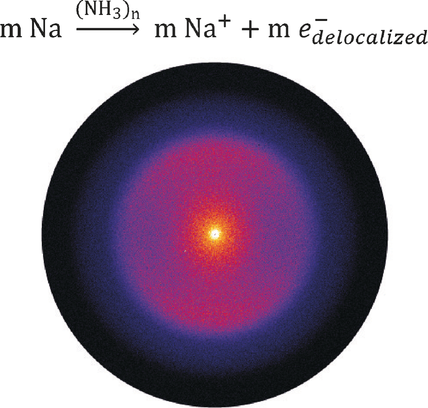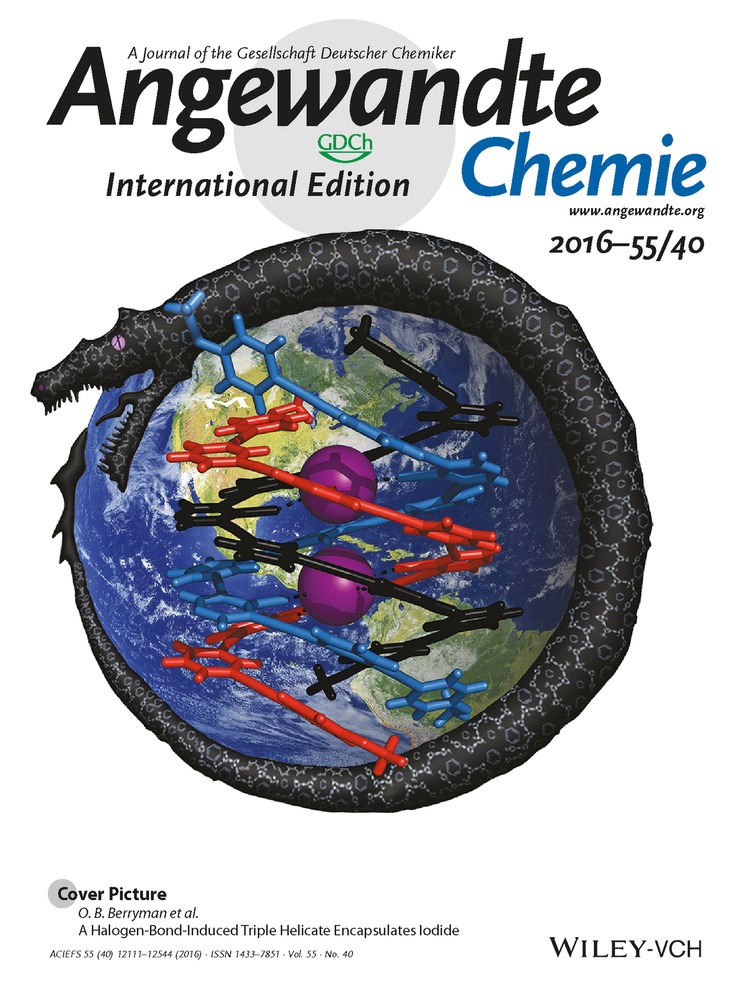Metal Transition in Sodium–Ammonia Nanodroplets
M. Sc. Sebastian Hartweg
Laboratory of Physical Chemistry, Department of Chemistry and Applied Biosciences, ETH Zürich, Vladimir-Prelog-Weg 2, 8093 Zürich, Switzerland
Search for more papers by this authorDr. Adam H. C. West
Laboratory of Physical Chemistry, Department of Chemistry and Applied Biosciences, ETH Zürich, Vladimir-Prelog-Weg 2, 8093 Zürich, Switzerland
Search for more papers by this authorDr. Bruce L. Yoder
Laboratory of Physical Chemistry, Department of Chemistry and Applied Biosciences, ETH Zürich, Vladimir-Prelog-Weg 2, 8093 Zürich, Switzerland
Search for more papers by this authorCorresponding Author
Prof. Dr. Ruth Signorell
Laboratory of Physical Chemistry, Department of Chemistry and Applied Biosciences, ETH Zürich, Vladimir-Prelog-Weg 2, 8093 Zürich, Switzerland
Search for more papers by this authorM. Sc. Sebastian Hartweg
Laboratory of Physical Chemistry, Department of Chemistry and Applied Biosciences, ETH Zürich, Vladimir-Prelog-Weg 2, 8093 Zürich, Switzerland
Search for more papers by this authorDr. Adam H. C. West
Laboratory of Physical Chemistry, Department of Chemistry and Applied Biosciences, ETH Zürich, Vladimir-Prelog-Weg 2, 8093 Zürich, Switzerland
Search for more papers by this authorDr. Bruce L. Yoder
Laboratory of Physical Chemistry, Department of Chemistry and Applied Biosciences, ETH Zürich, Vladimir-Prelog-Weg 2, 8093 Zürich, Switzerland
Search for more papers by this authorCorresponding Author
Prof. Dr. Ruth Signorell
Laboratory of Physical Chemistry, Department of Chemistry and Applied Biosciences, ETH Zürich, Vladimir-Prelog-Weg 2, 8093 Zürich, Switzerland
Search for more papers by this authorGraphical Abstract
When is a metal not a metal? For more than a century, chemists have been struggling for a detailed understanding of the intriguing concentration-dependent color change of metal–ammonia solutions from deep blue to copper-gold. Indications for the underlying nonmetal-to-metal transition have now been found in photoelectron images of sodium–ammonia nanodroplets, paving the way for an atomistic description.
Abstract
The famous nonmetal-to-metal transition in Na–ammonia solutions is investigated in nanoscale solution droplets by photoelectron spectroscopy. In agreement with the bulk solutions, a strong indication for a transition to the metallic state is found at an average metal concentration of 8.8±2.2 mole%. The smallest entity for the phase transition to be observed consists of approximately 100–200 solvent molecules. The quantification of this critical entity size is a stepping stone toward a deeper understanding of these quantum–classical solutions through direct modeling at the molecular level.
Supporting Information
As a service to our authors and readers, this journal provides supporting information supplied by the authors. Such materials are peer reviewed and may be re-organized for online delivery, but are not copy-edited or typeset. Technical support issues arising from supporting information (other than missing files) should be addressed to the authors.
| Filename | Description |
|---|---|
| anie201604282-sup-0001-misc_information.pdf1.7 MB | Supplementary |
Please note: The publisher is not responsible for the content or functionality of any supporting information supplied by the authors. Any queries (other than missing content) should be directed to the corresponding author for the article.
References
- 1
- 1aP. P. Edwards, Adv. Inorg. Chem. Radiochem. 1982, 25, 135–185;
- 1bD. Holton, P. Edwards, Chem. Br. 1985, 21, 1007–1013;
- 1cJ. M. Thomas, P. P. Edwards, V. L. Kuznetsov, ChemPhysChem 2008, 9, 59–66;
- 1dW. Weyl, Ann. Phys. 1864, 121, 601–612.
10.1002/andp.18641970407 Google Scholar
- 2E. Zurek, P. P. Edwards, R. Hoffmann, Angew. Chem. Int. Ed. 2009, 48, 8198–8232; Angew. Chem. 2009, 121, 8344–8381.
- 3
- 3aJ. M. Herbert in Reviews in Computational Chemistry, Vol. 28 (Eds.: ), Wiley, Hoboken 2015, pp. 391–517;
10.1002/9781118889886.ch8 Google Scholar
- 3bP. Vöhringer, Annu. Rev. Phys. Chem. 2015, 66, 97–118;
- 3cJ. M. Herbert, L. D. Jacobson, J. Phys. Chem. A 2011, 115, 14470–14483;
- 3dG. N. Chuev, P. Quémerais, J. Crain, J. Chem. Phys. 2007, 127, 244501.
- 4G. N. Chuev, P. Quémerais, J. Chem. Phys. 2008, 128, 144503.
- 5
- 5aA. J. Birch, D. K. C. MacDonald, Trans. Faraday Soc. 1948, 44, 735–742;
- 5bR. A. Ogg, Jr., Phys. Rev. 1946, 69, 243–244;
- 5cO. Ruff, J. Zedner, Ber. Dtsch. Chem. Ges. 1908, 41, 1948–1960.
- 6P. D. Schettler, Jr., A. Patterson, Jr., J. Phys. Chem. 1964, 68, 2865–2869.
- 7
- 7aC. A. Kraus, J. Am. Chem. Soc. 1907, 29, 1557–1571;
- 7bC. A. Kraus, W. W. Lucasse, J. Am. Chem. Soc. 1922, 44, 1949–1953;
- 7cP. Chieux, M. J. Sienko, J. Chem. Phys. 1970, 53, 566–570.
- 8D. S. Kyser, J. C. Thompson, J. Chem. Phys. 1965, 42, 3910–3918.
- 9J. C. Wasse, S. Hayama, S. Masmanidis, S. L. Stebbings, N. T. Skipper, J. Chem. Phys. 2003, 118, 7486–7494.
- 10
- 10aH. Aulich, B. Baron, P. Delahay, R. Lugo, J. Chem. Phys. 1973, 58, 4439–4443;
- 10bJ. Häsing, Ann. Phys. 1940, 37, 509–533.
- 11
- 11aB. L. Yoder, A. H. C. West, B. Schläppi, E. Chasovskikh, R. Signorell, J. Chem. Phys. 2013, 138, 044202;
- 11bA. H. C. West, B. L. Yoder, D. Luckhaus, C.-M. Saak, M. Doppelbauer, R. Signorell, J. Phys. Chem. Lett. 2015, 6, 1487–1492.
- 12
- 12aA. H. C. West, B. L. Yoder, D. Luckhaus, R. Signorell, J. Phys. Chem. A 2015, 119, 12376–12382;
- 12bR. Signorell, B. L. Yoder, A. H. C. West, J. J. Ferreiro, C.-M. Saak, Chem. Sci. 2014, 5, 1283–1295.
- 13
- 13aH. W. Sarkas, S. T. Arnold, J. G. Eaton, G. H. Lee, K. H. Bowen, J. Chem. Phys. 2002, 116, 5731–5737;
- 13bG. H. Lee, S. T. Arnold, J. G. Eaton, H. W. Sarkas, K. H. Bowen, C. Ludewigt, H. Haberland, Z. Phys. D 1991, 20, 9–12;
- 13cR. M. Young, D. M. Neumark, Chem. Rev. 2012, 112, 5553–5577.
- 14C. Steinbach, U. Buck, J. Chem. Phys. 2005, 122, 134301.
- 15A. H. C. West, B. L. Yoder, R. Signorell, J. Phys. Chem. A 2013, 117, 13326–13335.
- 16C. P. Schulz, A. Gerber, C. Nitsch, I. V. Hertel, Z. Phys. D 1991, 20, 65–67.
- 17
- 17aA. Herrmann, S. Leutwyler, E. Schumacher, L. Wöste, Helv. Chim. Acta 1978, 61, 453–487;
- 17bK. Wong, G. Tikhonov, V. V. Kresin, Phys. Rev. B 2002, 66, 125401;
- 17cC. Steinbach, U. Buck, Phys. Chem. Chem. Phys. 2005, 7, 986–990;
- 17dM. M. Kappes, M. Schär, U. Röthlisberger, C. Yeretzian, E. Schumacher, Chem. Phys. Lett. 1988, 143, 251–258.
- 18
- 18aB. von Issendorff, O. Cheshnovsky, Annu. Rev. Phys. Chem. 2005, 56, 549–580;
- 18bO. C. Thomas, W. Zheng, S. Xu, K. H. Bowen, Jr., Phys. Rev. Lett. 2002, 89, 213403;
- 18cA. Aguado, A. Vega, A. Lebon, B. von Issendorff, Angew. Chem. Int. Ed. 2015, 54, 2111–2115; Angew. Chem. 2015, 127, 2139–2143;
- 18dJ. Heinzelmann, P. Kruppa, S. Proch, Y. D. Kim, G. Ganteför, Chem. Phys. Lett. 2014, 603, 1–6;
- 18eG. L. Gutsev, C. A. Weatherford, B. R. Ramachandran, L. G. Gutsev, W. J. Zheng, O. C. Thomas, K. H. Bowen, J. Chem. Phys. 2015, 143, 044306.
- 19
- 19aB. Schläppi, J. J. Ferreiro, J. H. Litman, R. Signorell, Int. J. Mass Spectrom. 2014, 372, 13–21;
- 19bB. L. Yoder, J. H. Litman, P. W. Forysinski, J. L. Corbett, R. Signorell, J. Phys. Chem. Lett. 2011, 2, 2623–2628.





